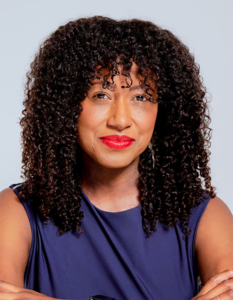Artificial Intelligence (AI) is rapidly transforming how we process information and tell stories. With deep fakes on the rise, Craig Newmark Philanthropies (CNP) and the Geena Davis Institute (GDI), known for their commitment to diversity, equity, and fairness, recently tackled this topic in a virtual See Jane Salon titled: AI Awareness Increases Cyber Safety In Our Schools, Screens, and Society. The event featured a panel of experts, who explored how media can inspire, educate, and empower the next generation, while addressing biases and fostering equitable representation in media.
Panelists included CNP grantees including Tarika Barrett, CEO of Girls Who Code; Ellen Pack, President, Common Sense Media; and B Cavello, Director Emerging Technologies, Aspen Institute. Their discussion centered on AI’s role in education and media, emphasizing the need for thoughtful implementation and safeguards.
With the shared belief that media can break stereotypes and change perceptions of the real world overnight, Craig and Geena emphasized the importance of showing women and young girls that AI offers new avenues for STEM education and careers. This message was delivered to an audience of content creators and media decision makers as it stressed that the inputs to AI must be diverse and it is imperative to have guardrails in place to ensure that AI becomes a force for good and not as one that continues to perpetuate negative stereotypes.
AI in STEM and Media Representation
Madeline Di Nonno, President & CEO of GDI, shared the Institute’s latest research findings from: “Portray Her 2.0: An Analysis of 15 years of Women in STEM on-Screen 2007-2022.” The report revealed a stark underrepresentation of women working in computer programming or computer science (15%) and none were shown working in AI or Cybersecurity.
Madeline moderated the panel and asked panelists to share their thoughts about how AI is shaping the media landscape. Following are the KEY TAKEAWAYS, supported by our panelists, and edited for brevity.
VISIBILITY MATTERS: Representation in media is crucial for inspiring diversity in STEM fields, particularly among young girls and underrepresented groups.

Tarika Barrett: At Girls Who Code, the goal is for more young women and nonbinary students to see themselves as the architects of our tech future. So much of what we’re doing right now is taking the mystery out of AI and supporting young people to feel empowered by the possibilities of this new technology.
MEDIA LITERACY: Developing media literacy skills is essential for children to critically engage with AI-related content and discern fact from fiction.
B Cavello: It’s really important that people be critical consumers of the stories that we hear about these tools. So one of the things that we do at Aspen Digital is build a foundational baseline of understanding about AI. We’ve released a series of primers on AI, AI 101 and Intro to generative AI. These resources were originally intended for journalists but what we found is everyone was using them, including policy makers and educators.
Ellen Pack: We’re out there trying to make sure students are thinking critically and responsibly about what is happening. “If you can see it, you should be able to think critically about it.”
EMPOWERING THROUGH EDUCATION: Educational initiatives and tools play a pivotal role in equipping youth with the knowledge and skills to thrive in an AI-driven world. Here are some examples:
Tarika Barrett: We introduced GirlJams.ai, a digital experience that allowed girls to learn the basics of AI by writing and creating art for and basically producing their own hit single.

Ellen Pack: We “rate, educate and advocate.” We look at these (AI) tools critically and objectively and say this is what they do. That’s the rate piece.” Our educate piece is AI literacy lessons. We have a curriculum for K-12.”
B Cavello: Everybody’s old enough to talk about AI but the way we talk about it changes. Having awareness of what data is (and how you might be generating it), fuels your understanding and curiosity about AI. That’s a conversation that can start at a really early age. One example of young people leading a conversation on these topics is our Next Gen Tech Fellows who are leading important research on questions related to AI.
IMPACT: Illustrating the possibilities and pitfalls of AI
Tarika Barrett: I want to mention one student, Rachel Sun. After her grandmother was put on dialysis, this high school junior wanted to help people with kidney disease. Rachel taught herself to code and created an app that uses AI to detect anemia in a user’s body. When our girls and nonbinary students see this, they can think outside the box when it comes to the possibilities of AI.
Ellen Pack: We set out and said, “we should rate AI.” It’s really important when you talk about impact. Everybody wants a good rating, right? Data and data privacy is an important piece as are basic safety and guardrails. Right now we say that AI models are better for creativity than for fact based exploration. A lot of the companies that we rated wanted to engage in this conversation.
B Cavello: We’re part of a community of folks working on public options for AI. I would love to see open source and public options for AI that allow educators, teachers, classrooms to experiment with, for instance, a computer vision tool in their science class to use language models within their history and social studies and English language arts classes. To try these tools and understand what they are good for and (what they’re not)!
In closing, Madeline Di Nonno asked the panelists to look through a crystal ball and asked what they would like to see 2 years from now.

B Cavello: I really hope to see a broader conversation about what it means to build an AI-ready America. So to me, what it looks like in 2 years time is really investing in these places where folks are on the ground who are doing the work. So they have the tools, the resources, and the media literacy education to do this.
Tarika Barrett: For us it’s making sure that our most marginalized students aren’t left behind. That means access to cyber education. That means access to AI education. It’s understanding that learning to code will always be the first, essential step to opening doors to learning about these emerging technologies.
Ellen Pack: I hope we will see less about where the technology is evolving and more clear policies that get in front of things.
Our panelists and all of us in the creative community agree that the powerful new technology of AI must be embraced mindfully. Craig Newmark’s goal is for everyone to be protected. Knowledge is power. While the Aspen Institute and Girls Who Code are using AI for good, Common Sense Media is working to ensure that AI remains good; and by hosting conversations like this panel, Craig Newmark Philanthropies and the Geena Davis Institute are leading the way to ensure that AI is inclusive, and opportunities in tech exist for everyone.
Resources:



